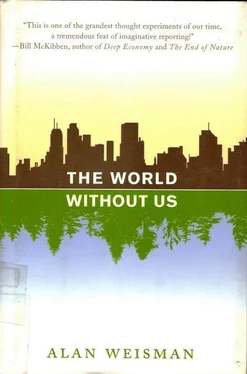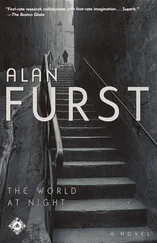Something about these limestone squares lying at the base of skeletal buildings looks familiar. After a while, he figures it out. “It is like Varosha.” The half-finished buildings going up, surrounded by construction rubble, exactly recall the half-ruins of Varosha coming down.
But if anything, quality has sunk even further. Each billboard touting Northern Cyprus’s sunny new dream homes includes, near the bottom, notification of the construction guarantee: 10 years. Given rumors of developers not bothering to wash the sea salt from the beach sand they mine for concrete, 10 years may be all they get.
Beyond the new golf course, the road finally narrows again. Past one-lane bridges stripped of their limestone ornaments, and a small canyon filled with myrtle and pink orchids, it enters the Karpaz Peninsula, the long tendril that reaches east toward the Levant. Along it are empty Greek churches, gutted but going nowhere, testaments to the tenacity of stone architecture. Stone structures were among the first things that distinguished sedentary humans from nomadic hunter-gatherers, whose temporary mud-and-wattle huts were no more permanent than the season’s grass. Stone buildings will be among the last to disappear when we’re gone. As the fleeting materials of modern construction decompose, the world will retrace our steps back to the Stone Age as it gradually erodes away all memory of us.
As the road follows the peninsula, the landscape gets biblical, with old walls turning back to hills as gravity tugs on the underlying clay. The island ends in sand dunes covered by salt scrub and pistachio trees. The beach is smoothed by the belly tracks of mama sea turtles.
A small limestone hill is topped by a lone, branching umbrella pine. Shadows on the rock face turn out to be caves. Closer, the soft parabola of a low-arched portal reveals that it’s been carved. At this windblown land’s end, less than 40 miles across the water to Turkey and only 20 miles more to Syria, the Stone Age began in Cyprus. Humans arrived around the same time that the oldest known building on Earth, a stone tower, was rising in the world’s oldest city that is still inhabited, Jericho. However primitive this Cyprus dwelling is by comparison, it represented a momentous step, albeit one taken some 40,000 years earlier by Southeast Asians who reached Australia—seafarers venturing beyond the horizon, out of sight of the shore, and finding another one waiting.
The cave is shallow, perhaps 20 feet deep, and surprisingly warm. A charcoal-smudged hearth, two benches, and sleeping niches were fashioned by cutting into the sedimentary walls. A second room, smaller than the first, is almost square, with a squared doorway arch.
Remains of Australopithecus in South Africa suggest that we were cavemen at least 1 million years ago. In a river bluff grotto at Chauvet-Pont-d’Arc in France, Cro-Magnons not only occupied caves 32,000 years ago, but also turned them into our first art galleries, depicting the European megafauna they sought, or whose strength they wished to channel.
There are no such artifacts here: these first inhabitants of Cyprus were struggling pioneers, their time for aesthetic reflection still ahead. But their bones are buried beneath the floor. Long after all our buildings and what’s left of the tower at Jericho are reduced to sand and soil, caves where we took shelter and first learned the notion of walls—including that they begged for art—will remain. In a world without us, they await the next occupant.
CHAPTER 8

What Lasts
IT IS HARD to see exactly what holds up the enormous round dome of Istanbul’s formerly Orthodox Christian, marble and mosaic-encrusted church of Hagia Sophia. More than 100 feet across, it is slightly smaller than the dome that crowns Rome’s Pantheon, but considerably higher. An inspired stroke of design divides its weight through a colonnade of arched windows at its base, making it appear to float. To gaze straight up at it, a gilded sky hovering 185 feet overhead, with no easy sense of why it stays aloft, leaves a beholder half-believing in miracles, and half-dizzy.
Over a thousand years, the dome’s weight has been further distributed among so many redoubled interior walls, additional half-domes, flying buttresses, pendentives, and massive corner piers that Turkish civil engineer Mete Sözen believes that not even a major earthquake would easily shake it loose. That is exactly what happened to its first dome, which fell just 20 years after it was completed in AD 537. That mishap led to all the subsequent reinforcement; even so, quakes severely damaged the church (which became a mosque in 1453) twice more until Mimar Sinan, the greatest architect of the Ottoman Empire, restored it in the 16th century. The delicate minarets the Ottomans added to its exterior will one day topple, but even in a world without people, meaning no masons to periodically repoint the Hagia Sophia’s mortar, Sözen expects much of it and other great ancient masonry edifices of Istanbul to last well into future geologic time.
Which is more than he can say, unfortunately, for the rest of the city of his birth. Not that it’s quite the same city. Through history, Istanbul, née Constantinople, née Byzantium before that, has changed hands so many times that it’s hard to imagine what could fundamentally alter it, let alone destroy it. But Mete Sözen is convinced that the former has already happened and the latter is imminent, whether humans stick around or not. The only difference in a world without people is that no one would be left to try to pick up Istanbul’s pieces.
When Dr. Sözen, who holds a chair in structural engineering at Indiana’s Purdue University, first left Turkey in 1952 for graduate studies in the United States, Istanbul had 1 million people. Half a century later, it has 15 million. He describes that as a far greater paradigm shift than its previous transformations from Delphic to Roman to Byzantine Orthodox to Crusader Catholic and, finally, to Muslim—in all its Ottoman and Turkish Republican strains.
Dr. Sözen sees this difference through an engineer’s eyes. Whereas all the previous conquering cultures erected fabulous monuments to themselves like the Hagia Sophia and the nearby ethereal Blue Mosque, the architectural expression of today’s hordes is manifest in more than 1 million multi-story buildings jammed into Istanbul’s narrow streets—buildings that he says are doomed to abbreviated life spans. In 2005, Sözen and a team he assembled of international architectural and seismic experts warned the Turkish government that within 30 years, the North Anatolian Fault that runs just east of the city will slip again. When it does, at least 50,000 apartment buildings will fall.
He’s still awaiting a response, although he doubts that anyone can imagine where to begin to stave off what his expertise deems inevitable. In September 1985, the U.S. government rushed Sözen to Mexico City to analyze how its embassy had weathered an 8.1-magnitude earthquake that collapsed nearly 1,000 buildings. The highly reinforced embassy, which he had examined a year earlier, was intact. Up and down Avenida Reforma and adjacent streets, however, many high-rise offices, apartments, and hotels had disintegrated.
It was one of the worst quakes in Latin American history. “But it was mostly confined to downtown. What occurred in Mexico City is a flake of what will happen to Istanbul.”
One thing that the two disasters, past and future, have in common is that nearly all the buildings that crumbled or will crumble were built after World War II. Turkey stayed out of that war, but its economy took the same beating as every other country’s. As industries recovered in the postwar European boom, thousands of peasants migrated to cities everywhere seeking jobs. Both the European and Asian sides of the Bosphorus Strait, which Istanbul straddles, filled with six- and seven-story housing of reinforced concrete.
Читать дальше












